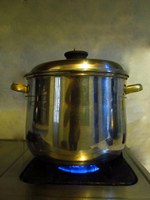Prairie Fare: Comfort Food Warms a Winter Night
(Click the image below to view a high-resolution image that can be downloaded)
By Julie Garden-Robinson, Food and Nutrition Specialist
NDSU Extension Service
“What’s that?” I asked as I breezed through the kitchen, noting a pot of simmering stew. My husband was head chef that evening and was trying a new recipe.
“I think they’re white beans, Mom,” our 15-year-old daughter said as she investigated the culinary creation.
“They look like little dumplings,” our 10-year-old daughter remarked.
“They’re too white to be beans, and I think they are too perfectly shaped to be dumplings,” I commented. I was in the living room, but I did an about-face and began walking back to take a closer look at the intriguing ingredient.
Our two daughters glanced at each other with the “what on earth are they going to feed us tonight?” look.
“This is hominy and pork stew. It’s good comfort food,” my husband noted.
I looked closer and, sure enough, it was hominy. My daughters probably never had tasted it.
Hominy is made by treating white or yellow maize with an alkali solution such as lye. The type of corn or maize used to make cornmeal also is used to make hominy. The alkali treatment removes the germ and hull and plumps the kernels. You can buy ready-to-use canned hominy in many grocery stores in the canned vegetables section.
One cup of hominy added to a recipe adds only 115 calories and 4 grams of fiber. One cup of hominy, as is, will add about 550 milligrams of sodium to a recipe. As with canned beans, draining and rinsing the hominy will help remove some of the sodium.
Dried hominy is ground to make “grits,” a popular breakfast cereal, particularly in the southern part of the U.S. This porridgelike cereal was created by early Native Americans from stone-ground corn.
Until I met my Indiana-raised husband I never had tasted hominy or grits. I was a little leery of the concoction simmering in the pot in our kitchen, but the aroma was delicious.
Any kind of soup, stew or chili ranks as “comfort food” in our house. With some bread, milk and fruit for dessert, we have a complete, balanced meal to warm a wintry night.
Comfort food first was defined officially in the dictionary in 1977. Comfort food is “food prepared in a traditional style having a usually nostalgic or sentimental appeal.” Comfort foods bring pleasure and might remind us of childhood experiences.
What’s your favorite comfort food? A study published in the Journal of Physiology and Behavior highlighted differences in what males and females define as comfort foods. Researchers surveyed more than 1,400 people. Male respondents to the survey preferred foods such as steak, casseroles and soup as their comfort foods. Females were more likely to prefer snack-type foods such as chocolate or ice cream. Younger people tended to prefer snack foods as their comfort foods.
Are you ready to try something a little different? I was skeptical that our daughters would try the stew, especially with the interesting spice combination and the cilantro and peppers used as the garnish. They raved about this stew. In fact, I quickly refrigerated a container for my next day’s lunch before my family devoured all of it.
Slow Cooker Hominy and Pork Stew
2 Tbsp. canola or sunflower oil
3/4 c. chopped onion
3 tsp. chopped garlic
1 1/2 pounds lean pork (such as pork chops), cut into bite-sized pieces
1 tsp. pureed chipotle peppers in adobo sauce
1/4 tsp. cumin
1/2 tsp. oregano
2 (14.5-ounce) cans reduced-sodium chicken broth (about 3 1/4 cups)
1 (29-ounce) can hominy, drained and rinsed
1 (14.5-ounce) can diced reduced-sodium tomatoes (with juice)
Optional toppings (chopped cilantro, fresh sliced jalapenos*)
Trim any visible fat from the pork, then cut into bite-sized pieces. Heat oil in pan over medium heat, and add onion, garlic and pork. Cook until pork is browned and onions are translucent. (Watch closely so the garlic does not burn.) Place pork, onions and garlic in a slow cooker, and add all remaining ingredients. Mix and cook on low for about eight hours. Top with chopped fresh cilantro and jalapenos right before serving.
Alternate directions: This can be simmered on a stovetop if you plan to remain at home during the cooking process. If the stew thickens too much, add additional broth.
(* Note: To decrease “heat” in the peppers, remove the seeds and veins.)
Makes 10 servings. Each serving has 210 calories, 9 grams (g) of fat, 19 g of protein, 11 g of carbohydrate, 2 g of fiber and 600 milligrams of sodium.
(Julie Garden-Robinson, Ph.D., R.D., L.R.D., is a North Dakota State University Extension Service food and nutrition specialist and professor in the Department of Health, Nutrition and Exercise Sciences.)
NDSU Agriculture Communication – Feb. 6, 2014
| Source: | Julie Garden-Robinson, (701) 231-7187, julie.garden-robinson@ndsu.edu |
|---|---|
| Editor: | Rich Mattern, (701) 231-6136, richard.mattern@ndsu.edu |


